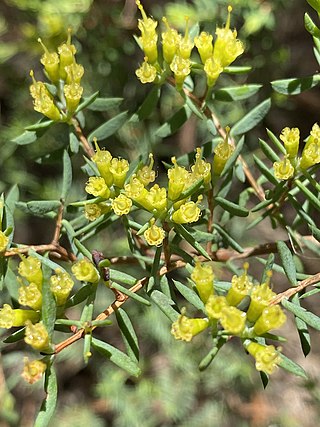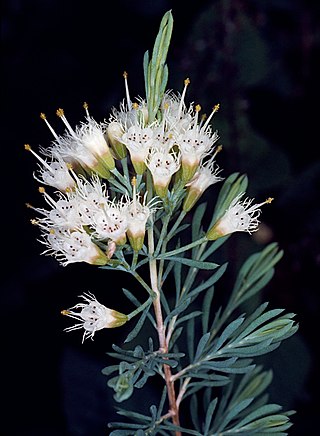
Homoranthus is a genus of about thirty species of plants in the myrtle family Myrtaceae and all are endemic to Australia. Plants in this genus share similarities with those in both Darwinia and Verticordia. They are shrubs with their leaves arranged in opposite pairs and with flowers appearing either singly or in small groups, usually in upper leaf axils. They are found in Queensland, New South Wales and South Australia. The genus was first described in 1836. None of the species is common nor are they well-known in horticulture.

Homoranthus wilhelmii, commonly known as the eastern feather flower, is a species of flowering plant in the family Myrtaceae and is endemic to South Australia. It is a small, spreading shrub with cylindrical to flattened leaves and white or pink flowers arranged in corymbs on the ends of branchlets. The distribution includes an area on the Yorke Peninsula, but it is most common on the southern Eyre Peninsula.

Melaleuca squarrosa, commonly known as scented paperbark, is a plant in the myrtle family, Myrtaceae and is endemic to south eastern parts of Australia, especially Tasmania. It is an attractive shrub with dense foliage and arching branches and it flowers profusely in spring or early summer, bearing spikes of perfumed yellow to white flowers.

Homoranthus darwinioides, commonly known as fairy bells, is a species of flowering plant in the family, Myrtaceae. It is a small, spreading shrub with pendulous yellow and pink flowers, grey-green leaves and is endemic to New South Wales.

Homoranthus papillatus, commonly known as mouse bush, is a flowering plant in the family Myrtaceae and is endemic to a small area in southern Queensland. It is a compact shrub with curved, linear leaves and pale yellow flowers arranged in upper leaf axils.
Kunzea caduca is a plant in the myrtle family, Myrtaceae and is endemic to Queensland. It is a spreading shrub with linear to lance-shaped leaves and groups of white to cream-coloured flowers on the ends of all the branches from late winter to early spring. It is only known from a few locations and only conserved in the Castle Tower National Park near Gladstone.

Kunzea flavescens is a plant in the myrtle family, Myrtaceae and is endemic to Queensland. It is a spreading shrub which has egg-shaped leaves and groups of white or cream-coloured flowers on the ends of the branches in September and October.

Kunzea graniticola is a plant in the myrtle family, Myrtaceae and is endemic to Queensland. It is a shrub or small tree with linear to egg-shaped leaves and rounded groups of white or cream-coloured flowers on the ends of the branches in August and September. It is only known from forests near Cardwell and on Hinchinbrook Island.

Homoranthus biflorus is a flowering plant in the family Myrtaceae and is endemic to a small area in northern New South Wales. It is an erect shrub with cylinder-shaped leaves and small groups of usually yellow flowers.

Homoranthus bebo is a flowering plant in the family Myrtaceae and is endemic to a small area in northern New South Wales. It is a low-lying shrub with leaves that are usually flat and with groups of up to ten yellow flowers. It is only known from the Dthinna Dthinnawan Nature Reserve near Yetman.

Homoranthus coracinus is a flowering plant in the family Myrtaceae and is endemic to a small area in Queensland. It is a low, spreading shrub with pointed, narrow, egg-shaped leaves and groups of up to six flowers with black petals. It is only known from a single population in the Ka Ka Mundi part of the Carnarvon National Park.

Homoranthus croftianus, commonly known as Bolivia homoranthus, is a plant in the myrtle family Myrtaceae and is endemic to a small area near Bolivia in northern New South Wales. It is an upright shrub with pointed leaves arranged in alternating opposite pairs so they form four rows along the branchlets. Single greenish to cream-coloured flowers are borne in leaf axils.

Homoranthus lunatus, commonly known as crescent-leaved homoranthus, is a flowering plant in the family Myrtaceae and is endemic to a small area in northern New South Wales. It is a spreading shrub with curved leaves and small groups of up to six yellow flowers in leaf axils.

Homoranthus melanostictus is a flowering plant in the family Myrtaceae and is endemic to eastern Australia. It has cylinder-shaped to flattened leaves with blackish oil dots and up to six yellow flowers arranged in leaf axils near the ends of the branchlets.

Homoranthus montanus is a plant in the myrtle family Myrtaceae and is endemic to a small area in southern Queensland. It has narrow leaves and up to one to six small tubular, cream-coloured flowers arranged in leaf axils near the ends of the branchlets. As the flowers age, they turn red.

Homoranthus porteri is a plant in the myrtle family Myrtaceae, and is endemic to a small area in northern Queensland, Australia. It is an upright shrub with creamy-white to red pendulous flowers in pairs on a short stalk with red bracts and small linear leaves.

Homoranthus prolixus, commonly known as granite homoranthus is a flowering plant in the family Myrtaceae and is endemic to northern New South Wales. It is a spreading shrub with linear to lance-shaped leaves and groups of up to six yellow to red flowers in the upper leaf axils.

Homoranthus thomasii is a species of flowering plant in the family Myrtaceae and is endemic to Queensland. It is a small shrub with spoon-shaped, greyish green leaves and small, pendulous, pink flowers in the upper leaf axils.
Homoranthus tricolor, is a flowering plant in the family Myrtaceae and is endemic to a small area in south-east Queensland. It is an upright shrub with linear to lance-shaped leaves and green, red and black flowers arranged singly or in pairs in upper leaf axils.

Homoranthus tropicus is a flowering plant in the family Myrtaceae and is endemic to tropical north Queensland. It is a shrub with curved, club-shaped leaves and white flowers in a corymb-like arrangement on the ends of branchlets.


















